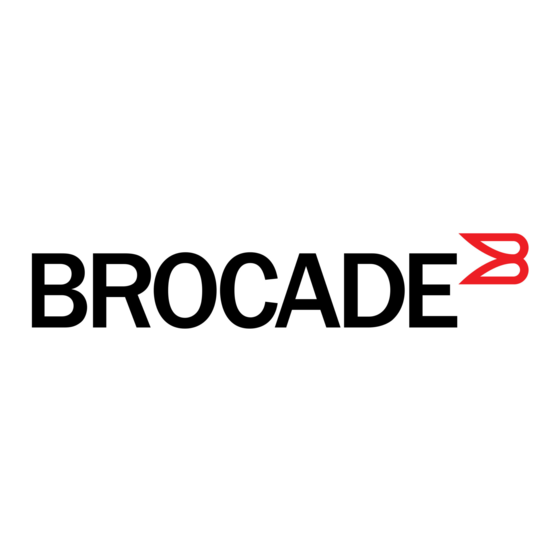

Brocade Communications Systems PowerEdge M420 Quick Start Manual
Brocade 4424 blade server san i/o quickstart guide
Hide thumbs
Also See for PowerEdge M420:
- Hardware reference manual (48 pages) ,
- Hardware reference manual (48 pages)
Table of Contents
Advertisement
Quick Links
Advertisement
Table of Contents

Summary of Contents for Brocade Communications Systems PowerEdge M420
- Page 1 53-1000572-01 November, 2007 Brocade 4424 QuickStart Guide...
-
Page 2: Document History
Copyright © 2007, Brocade Communications Systems, Incorporated. Publication Number: ALL RIGHTS RESERVED. 53-1000572-01 Brocade, the Brocade B weave logo, Fabric OS, File Lifecycle Manager, MyView, Secure Fabric OS, SilkWorm, and StorageX are registered trademarks and the Brocade B wing logo, SAN Health, and Tapestry are trademarks of Brocade Communications Systems, Inc., in the United States and/or in other countries. -
Page 3: Unpacking And Installing The San I/O Module
SAN I/O Module. NOTE The SAN I/O Module is designed to work only in I/O bays B1/B2 and C1/C2 of the Dell M1000e Blade Server Enclosure. Make sure to comply with installation requirements in the Blade Server Enclosure Hardware Owner’s Manual. -
Page 4: Cabling Guidelines
Cabling guidelines After modifying the SAN I/O Module’s IP address and domain name (if Module is in Fabric Switch mode), we recommend that you cable all external ports to fabric connections before bringing the SAN I/O Module online. Refer “Configuring the SAN I/O Module” on page 6 for steps on modifying the IP address. -
Page 5: Modify The San I/O Module Ip Address
• Access Gateway Administrator’s Guide • Web Tools Administrator’s Guide Modify the SAN I/O Module IP address By default, the IP address for the SAN I/O Module is configured as 10.77.77.77 with a default Ethernet subnetmask of 255.255.255.0. Reset the IP address using three methods. If the IP values are set using either of these methods, the IP values are stored on the SAN I/O Module. - Page 6 • Bits per second: 9600 • Databits: 8 • Parity: None • Stop bits: 1 • Flow Control: None For LINUX or UNIX a. Enter the following at the command prompt: tip /dev/ttyb -9600 b. When the terminal application stops reporting information, press Enter to display the login prompt. Log in using the default administrative account Login: admin Password: password...
-
Page 7: Connecting The San I/O Module To The Ethernet Network
4. Use the appropriate CLI commands to change the IP address of the selected SAN I/O module. Refer to your Blade Server Enclosure CLI documentation. Using the CMC GUI to set the IP address To change the IP address, use the following steps: 1. -
Page 8: Connecting The San I/O Module To The Fabric
Connecting the SAN I/O Module to the fabric NOTE Refer to “Cabling guidelines” on page 6 before beginning the following procedure. Before beginning the following steps, determine whether the SAN I/O Module is in Access Gateway or Full Fabric Switch mode. This affects the configuration process. Using the SAN I/O Module CLI, you can enter the ag –– modeShow command to determine the current operating mode. - Page 9 ssl attributes (yes, y, no, n): [no] http attributes (yes, y, no, n): [no] snmp attributes (yes, y, no, n): [no] rpcd attributes (yes, y, no, n): [no] cfgload attributes (yes, y, no, n): [no] webtools attributes (yes, y, no, n): [no] System (yes, y, no, n): [no] WARNING: The domain ID will be changed.
-
Page 10: Changing From Fabric Switch Mode To Access Gateway Mode
9. Back up the SAN I/O Module configuration to an FTP server by typing the configUpload command and following the prompts. This command uploads the SAN I/O Module configuration to the server, making it available for downloading to a replacement SAN I/O Module if necessary. Brocade recommends backing up the configuration on a regular basis to ensure that a complete configuration is available for downloading to a replacement SAN I/O Module. -
Page 11: Command Line Interface
NOTE You should save the configuration file if you are converting an SAN I/O Module to Access Gateway mode. To save your current configuration, click the Show Advanced Mode button in the top right-hand corner of the Switch Administration window. Select the Configure tab, then select the Upload/Download tab. Enter the relevant information to upload the configuration file. -
Page 12: Activating Ports On Demand (Pod)
Notes • A license is required for Dual Function Mode, which allows you to switch between Access Gateway and Standard Full Fabric Switch Mode. If your SAN I/O Module was shipped in Access Gateway Mode, you cannot switch to Fabric Switch Mode without this license. You can also use the CLI licenseshow command to determine whether the module is Dual Function (Switch), or Access Gateway. -
Page 13: Connecting To The San I/O Module Using Web Tools
3. Enable the SAN I/O Module using Web Tools or CLI. When the SAN I/O Module is enabled, the newly-added POD ports are also enabled. Connecting to the SAN I/O Module Using Web Tools Complete the following steps to connect to the SAN I/O Module using Web Tools. 1. - Page 14 16 of 16 4424 QuickStart Guide Publication Number: 53-1000572-01...




Need help?
Do you have a question about the PowerEdge M420 and is the answer not in the manual?
Questions and answers